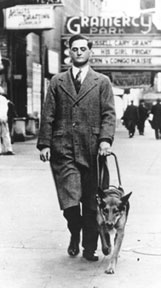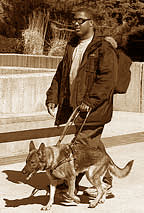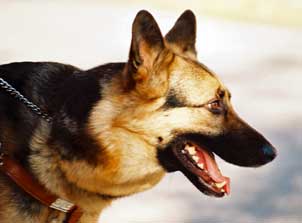The intelligent German Shepherd Dogs excel as service dogs
German Shepherds are great service dogs and are the world's premier working dog. Super intelligent, extremely versatile, loyal to no end, German Shepherds were created right from the beginning to be the best assistant a person could ever have.
Utility was the founding breed idea from the beginning, always in the mind of the breed founder, Max von Stephanitz. German Shepherds were bred to do a job. In fact, they need to do a job. And if you do not find one for them, they'll find one for themselves.
What exactly is an assistance dog?
Briefly, the phrase means a dog that assists people with some sort of problem in one way or another, such as: as a guide dog that leads and assists blind people; as a seizure dog trained to alert it's owner before a seizure happens; as a hearing dog to alert it's deaf owner to various alarms, noises, etc. which the owner cannot hear; as a dog that assists individuals with disabilities to pull a wheelchair, pick up dropped items; and trained in a multitude of other useful tasks to help their owners.
Historically, this service team paved the way for the entire future of service dogs. Since that time dogs have been trained to help people in many ways so that they can live a more independent and happy life.
 |
 |
First and foremost, the German Shepherd, was a pioneer in the field of assistance dogs in the United States and in the world.
In the late 1920's, a German Shepherd Dog named Buddy was paired with a blind man named Morris Frank and became the first guide dog team in the U.S.
Currently there are many organizations on both the national and local level that select, acquire, train and place these dogs with the people who need them most. Some even breed their own dogs for these service related positions while others acquire their dogs from shelters, rescue organizations, and through private donations. Sometimes volunteers are recruited to aid in the beginning socialization of these future service dogs (puppy raisers) while the majority of training happens with specialized trainers.
Additionally, the new disabled owner must be trained as well to work with and care for their new canine partner. These
dog and owner teams will attend training classes to learn how to work
together, as well as how to groom, feed and care for their new canine
companions. These working service dog teams do a great deal to educate
the public about the abilities of the service dog, their importance to
mankind and most importantly, how to interact with these working dogs
while they work.

Do's & Don'ts When Around a Assistance Dog Team
DO's:
Talk to the person just as you would to anyone else that you might come in contact with on a daily basis.
If you notice that the person may need help, ask the person if they need additional help first before just coming to their rescue.
If the person does want additional help, offer your arm to allow the disabled person to help themselves. Let them handle their own dog personally. If the person does need help, offer your arm - do not pull on the disabled person.
Ask the person questions about their dog. They would probably enjoy telling you all about their assistance dog.
DONT'S:
Never pet, distract in any way or offer a working dog food.
Never attempt to take the dogs harness or leash from the dog's owner.
Do not talk down to the person. Being physically disabled does not mean that there is any lack of intelligence.
Return from service dogs to GSD guide dogs
"Dogs laugh, but they laugh with their tails. What puts man in a higher state of evolution is that he has got his laugh on the right end." - Max Eastman
Sign up for promotions, news, discounts, and the chance to win prizes for you and your German Shepherd
